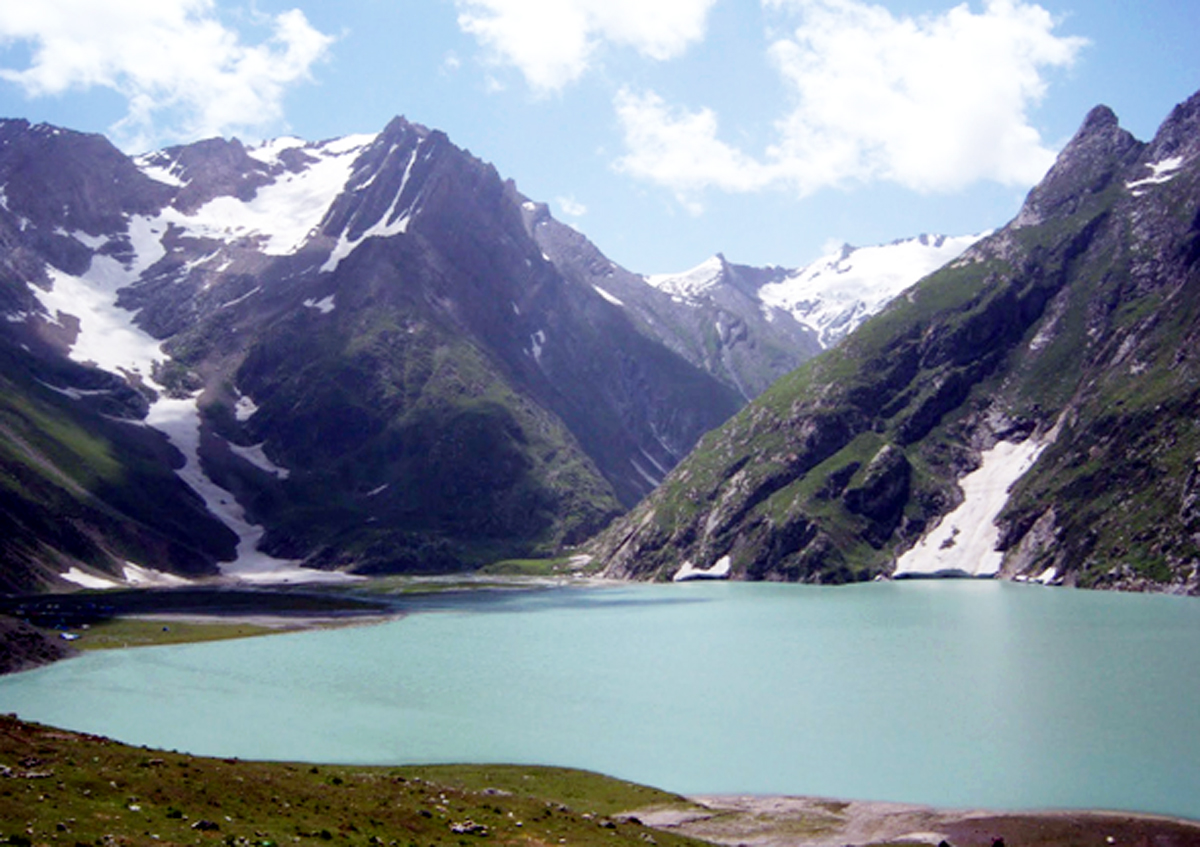Romesh Kumar Pandita
Situated 120 kilometres east from Srinagar and 23 km from Pahalgam Sheshnag Lake derives its name from the Hindu mythology that considers Sheshnag as the King of the Nagas, or the serpent God with six heads. Sheshnag Lake is mainly fed by the streams originating from glaciers and snow clad mountains all round its periphery overlooking this magnificent and beautiful lake.
The lush green lake water usually freezes during winter. Along with its scientific importance, the lake has special significance for Hindu followers as well. The Lake is Oligotrohic Lake (water body that has low content of algal production and thus is clear water of high drinking quality) and lake appears greenish in colour because of lush green meadows making it breathtaking beauty to admire. Sheshnag Lake is an alpine high altitude lake situated along side of track leading to Amarnath Cave 23 kilometres from Pahalgam in Anantnag district of Kashmir valley in the Indian state of Jammu and Kashmir at an elevation of 3590 meters. Though there are various mythological stories related to the lake but the most commonly believed one is that Sheshnag Lake basically belongs to Sheshnag, the Lord of Snakes, and is said to be dug by the Lord himself. Because of its presence on the route to holy Amarnath Cave, Sheshnag Lake is also a sacred pilgrimage site. Travellers can easily trek this must visit Pahalgam tourist place from Chandanwadi Valley, which is only about 12 KMs away.
The Sheshnag Lake can only be visited for a few months during the year, after which it freezes. Even during peak summers, the water of the lake remains ice cold.
Travellers have to climb up through a steep mountain Pass called Pissutop and then cross the valley called Pissu-ghati, followed by climbing Kutta Gati at Zojibal, before reaching Sheshnag Lake. The Scenic view of the valleys and snow clad peaks in a distance are magnificent and mesmerising.
There are no hotels or guest houses around the lake except tented accommodation in the camping site during Yatra period every year ; away from lake to maintain sanctity of the sacred lake.
The Lake is mainly fed by glacier discharge through Gratbal nallah joining it from catchment area of MG top side and number of snow/glacier fed nallah on southern side. Theses nallahs carry lot of bed loads in the shape of Gravel (of different sizes) and sand. Gravel, sand in the shape of bed load of these nallahs gets deposited in the sacred lake.
It is stated that the lake had an area of about 5 Square Miles and a depth of 250 feet in the past. But over the years of its existence, the lake has shrunk to an area of 0.77 Sq. Km (1.10 Km in length and o.70 Km in width (app.), due to two main reasons; i ) the deposition of the huge bed load (gravel of different sizes & sand) in the streams that bring water discharge into the lake area ii) progressive erosion of bed rock on outflow side that has resulted in reduction of storage level within the lake level. The discharge streams carrying bed load of sand and gravel and progressive erosion of a weir type natural obstruction of rock has resulted in reduction of the poundage in the lake both in spread area and depth of a beautiful and mesmerising lake. It has been observed that size of the sacred lake has reduced by at least by 30% past few years due to aforesaid reasons.
Hindu Pilgrims who come from far off places within the country and abroad attach a lot of significance to the Sacred Lake during their travel from Chandanwari to Holy Amarnathji Cave because they believe,Lord Shiva on his way to Holy Cave to narrate Amar Katha to Mata Parawati, released Sheshnag in this lake.
Lidder River which originates from western side of this magnificent lake in the shape of beautiful meandering stream through mountainous ranges is joined by numberless streams enroute to Pahalgam where it is joined by another major tributary coming from Arav Valley. The discharge from Sheshnagh has over the years progressively eroded the level of rock at the exit point of the lake; creating a v notch; leading to reduction of the natural poundage level in the sacred Sheshnag Lake thus resulting in shrinkage of water storage area. The depth of the lake is constantly reducing year after year due to settlement of aggregate and sand carried as bed load by the incoming tributaries.
Scores of environmentalists and other agencies within and outside state have been highlighting the environmental concerns due to impact of Shri Amarnathji Yatra; though the same runs for a brief period in a year. But none of these environmentalist/agency has ever raised concern of regarding shrinking of the lake due to deposition of huge bed load in the body of lake and depletion of poundage of the bed rock on exit side.
Centre and State Government authorities have been giving lot of attention to developments at religious places both at Jammu and Srinagar provinces and a the Central Government has been providing lot of funds to promote religious tourism. The authorities need to pay attention to the problem of scouring of the bank on outlet side of the sacred lake; and consider ways and means for raising of level by way of construction of weir type structure for raising the poundage level in the lake and also take other appropriate preventive measures to save the lake from shrinking further.
Trending Now
E-Paper


